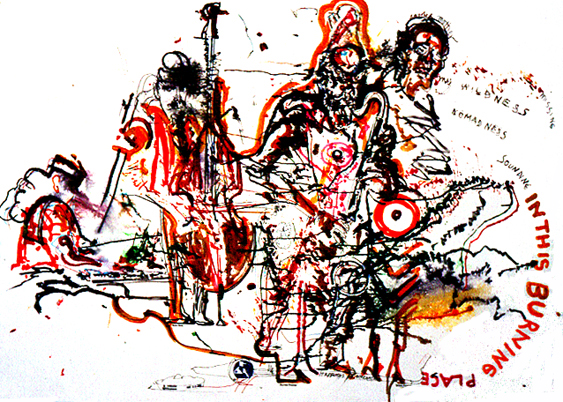 |
| ALAN SILVA | OLUYEMI THOMAS | IJEOMA THOMAS |
For two and ½ grandiose weeks in early summer, the Seventh Annual Vision Festival was host to some of the most significant creative work being performed today. Under the superb guidance of William Parker and Patricia Nicholson Parker, the seventh annual festival was logged into the record books by celebrating in fine style the musical, dance, visual, and poetic art forms. Performed by an outstandingly talented multinational cast, the festival paid tribute to professional artistry that is worlds apart from the commercial fare being foisted on the public by more enterprising fests. Visual artist Jeff Schlanger captured on paper the essence of over 50 concerts through his uniquely keen perception of the music, and many of his works are depicted in this article, along with narratives and photographs from the nights I was able to attend. Jeff said, "The spread of expression was amazing over the entire period. The last weekend with an expanded stage, dancers with great musicians, video, film, and scenic artists was an extraordinary and fresh creative zone." Vision 2002 was truly a feast for the eyes and ears, and the vibrations of its dynamic impact remain implanted in the minds and on the souls of those who witnessed it.
| 23 & 24 MAY |
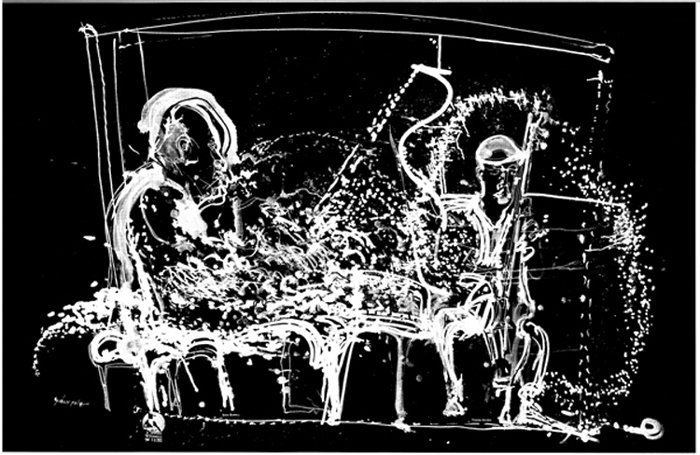 |
| DAVE BURRELL | TYRONE BROWN |
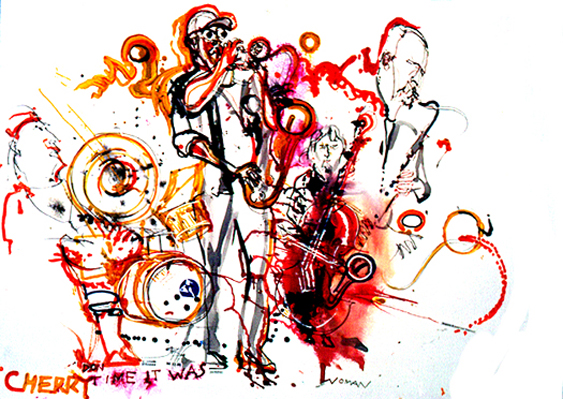 |
| SHADOW
& LIGHT TANI TABBAL | JOE MCPHEE | MIKE BISIO | JOE GIARDULLO |
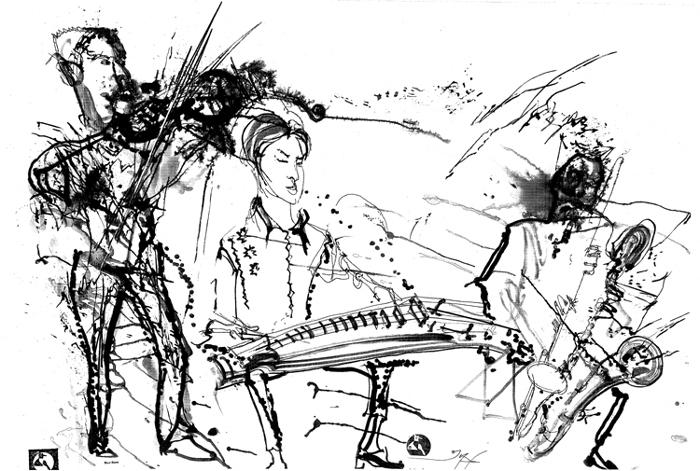 |
| BILLY BANG PROJECT |
Billy Bang Project
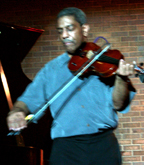 The
The
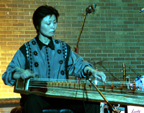 Billy
Bang Project is an intriguing amalgam of strings and reeds. This trio,
with stellar baritone, bass clarinet, and flute player Hamiet Bluiett,
and komungo player Jin Hi Kim, emitted mesmerizing music. Much of the
program reflected on Bang's musical interpretation of his experiences
during the Vietnam War, which gave the set a gripping tonality. Bluiett
was delicate on flute yet powerful on the big, floor-standing deep horns.
Kim was wizardly on her Korean 6-string, fretted, board zither. She and
Bang danced in and out of improvised raindrops while exuding emotional
cohesiveness. The all-too-short set keenly showed the mastery of Bang's
improvising talent and conceptual creativity.
Billy
Bang Project is an intriguing amalgam of strings and reeds. This trio,
with stellar baritone, bass clarinet, and flute player Hamiet Bluiett,
and komungo player Jin Hi Kim, emitted mesmerizing music. Much of the
program reflected on Bang's musical interpretation of his experiences
during the Vietnam War, which gave the set a gripping tonality. Bluiett
was delicate on flute yet powerful on the big, floor-standing deep horns.
Kim was wizardly on her Korean 6-string, fretted, board zither. She and
Bang danced in and out of improvised raindrops while exuding emotional
cohesiveness. The all-too-short set keenly showed the mastery of Bang's
improvising talent and conceptual creativity.
Joe Morris Quartet
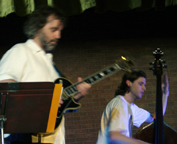 The
Joe Morris Quartet played with sparkle and concentrated energy. Morris
has a uniquely clear and direct sound that gives him an improvising advantage.
He is able to spin off round after round of free verse containing intricately
developed phrases without ever resorting to distortion or special effects.
Alto saxophonist Jim Hobbs was an excellent foil for Morris. He perpetuated
lengthy solos of his own in congress with the directional beams from Morris.
Bassist Timo Shanko and drummer Luther Gray established a substantial
motive backdrop on this freewheeling set. The music was absorbing in a
sobering way, often taking flight with spiraling reams of upper-register
notes leaving their residue in the air while the thunderous rhythms echoed
beneath. They played with solidarity and an authoritative attitude, and
their closing number "Witness" was a definite winner.
The
Joe Morris Quartet played with sparkle and concentrated energy. Morris
has a uniquely clear and direct sound that gives him an improvising advantage.
He is able to spin off round after round of free verse containing intricately
developed phrases without ever resorting to distortion or special effects.
Alto saxophonist Jim Hobbs was an excellent foil for Morris. He perpetuated
lengthy solos of his own in congress with the directional beams from Morris.
Bassist Timo Shanko and drummer Luther Gray established a substantial
motive backdrop on this freewheeling set. The music was absorbing in a
sobering way, often taking flight with spiraling reams of upper-register
notes leaving their residue in the air while the thunderous rhythms echoed
beneath. They played with solidarity and an authoritative attitude, and
their closing number "Witness" was a definite winner.
Muntu
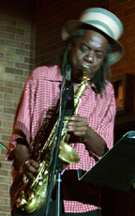 Jemeel
Moondoc's first working group of several decades ago (he called it a practice
band, meaning they did not work often) was Muntu. The quartet was reunited
for this 2002 Vision Festival. Although it is a fiery band, the embers
do not glow as white heat; instead, they exude a contained state of energy
that stops just short of total chaos. While Rashid Bakr exploded grenades
all around, Moondoc and Roy Campbell blew with passion and controlled
energy. William Parker, a mainstay at this festival, continued to anchor
the music with his relentless pulsation. Moondoc took extended improvised
journeys while Campbell maintained reference to the loosely cut themes,
and then they switched roles. Muntu's music is based on the song form
as opposed to spontaneous composition, but it does not keep its members
from roaming the spaceways. Their playing of an Albert Ayler composition
was particularly telling.
Jemeel
Moondoc's first working group of several decades ago (he called it a practice
band, meaning they did not work often) was Muntu. The quartet was reunited
for this 2002 Vision Festival. Although it is a fiery band, the embers
do not glow as white heat; instead, they exude a contained state of energy
that stops just short of total chaos. While Rashid Bakr exploded grenades
all around, Moondoc and Roy Campbell blew with passion and controlled
energy. William Parker, a mainstay at this festival, continued to anchor
the music with his relentless pulsation. Moondoc took extended improvised
journeys while Campbell maintained reference to the loosely cut themes,
and then they switched roles. Muntu's music is based on the song form
as opposed to spontaneous composition, but it does not keep its members
from roaming the spaceways. Their playing of an Albert Ayler composition
was particularly telling.
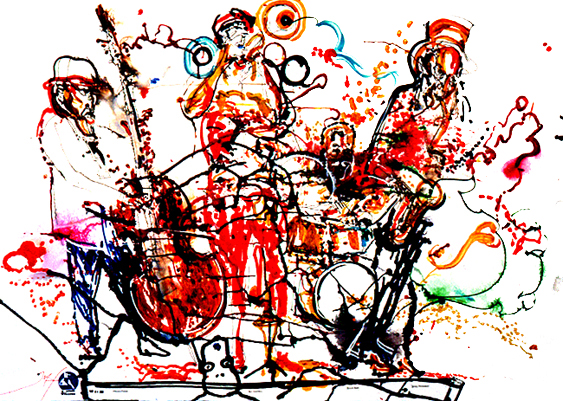 |
| MUNTU |
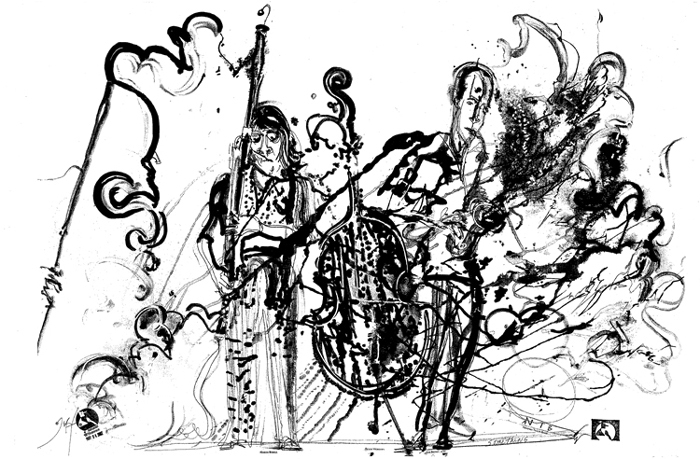 |
| KAREN BORCA QUARTET |
Karen Borca Quartet
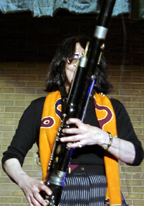 Karen
Borca was at the top of her game on this night. She blew with fierce intensity
and was able to make the normally docile bassoon sing with energy. Borca
emitted long lines of flowing gracefulness, filling her solos with substance
and diversity. Her quartet was just as dynamic. Rob Brown has consistently
shown his talent for developing long, logical alto improvisations. He
was in the proper spirit and played zealously in tandem with Borca or
singly. The huge thrill of seeing Reggie Workman in action made the set
even more enticing. The master bassist continues to produce phenomenal
phrases of multi-string intricacy and complexity. He is an ongoing joy
and seems to get better with age. Drummer Newman Taylor-Baker was the
right foil for igniting this group, which played three extended, well-constructed
free improvisations. It was a good night for music.
Karen
Borca was at the top of her game on this night. She blew with fierce intensity
and was able to make the normally docile bassoon sing with energy. Borca
emitted long lines of flowing gracefulness, filling her solos with substance
and diversity. Her quartet was just as dynamic. Rob Brown has consistently
shown his talent for developing long, logical alto improvisations. He
was in the proper spirit and played zealously in tandem with Borca or
singly. The huge thrill of seeing Reggie Workman in action made the set
even more enticing. The master bassist continues to produce phenomenal
phrases of multi-string intricacy and complexity. He is an ongoing joy
and seems to get better with age. Drummer Newman Taylor-Baker was the
right foil for igniting this group, which played three extended, well-constructed
free improvisations. It was a good night for music.
| 25 MAY |
Kalaparusha Maurice McIntyre
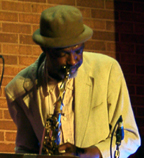 Any
chance to see the elder statesman Maurice McIntrye in performance is an
event in itself. The AACM emeritus displayed no signs of slowing down
as he directed a youthful group through four of his compositions. Instead
of a bassist, he employed tuba player Jesse Dulman, and drummer Ravish
Momin kept the alternate heartbeat. McIntyre played with mellow intensity,
spewing out lovely melodic lines and highly refined improvised passages.
The reed/brass combination with a percussion backdrop was very effective.
McIntyre was particularly impressive on the Coltrane dedication piece
"Indian Man," and the set flew by in what seemed a heartbeat.
Any
chance to see the elder statesman Maurice McIntrye in performance is an
event in itself. The AACM emeritus displayed no signs of slowing down
as he directed a youthful group through four of his compositions. Instead
of a bassist, he employed tuba player Jesse Dulman, and drummer Ravish
Momin kept the alternate heartbeat. McIntyre played with mellow intensity,
spewing out lovely melodic lines and highly refined improvised passages.
The reed/brass combination with a percussion backdrop was very effective.
McIntyre was particularly impressive on the Coltrane dedication piece
"Indian Man," and the set flew by in what seemed a heartbeat.
Milford Graves / Kidd Jordan / William Parker
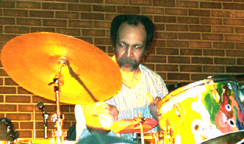 What
What
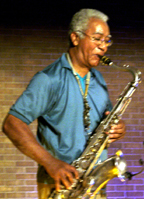 do
you get when you combine the provocative drumming of Milford Graves, the
powerhouse blowing of Kidd Jordan, and the motivating pulsation of bassist
William Parker? These three ingredients were all that were necessary to
form an eruptive team of freewheeling proportions. It was a condensed
seminar on creative art meeting spontaneous energy as three giants of
improvised music met on a common battlefield. Graves fueled an overheated
furnace with his rampaging attack, Jordan formulated incendiary missles
that launched on command, and Parker worked overtime to propel the movement
off the launching pad. It all resulted in an exciting session of overwhelming
proportions that was draining for both the artists and the audience. Moments
in music such as these are rare, but this trio made the connectivity their
private domain.
do
you get when you combine the provocative drumming of Milford Graves, the
powerhouse blowing of Kidd Jordan, and the motivating pulsation of bassist
William Parker? These three ingredients were all that were necessary to
form an eruptive team of freewheeling proportions. It was a condensed
seminar on creative art meeting spontaneous energy as three giants of
improvised music met on a common battlefield. Graves fueled an overheated
furnace with his rampaging attack, Jordan formulated incendiary missles
that launched on command, and Parker worked overtime to propel the movement
off the launching pad. It all resulted in an exciting session of overwhelming
proportions that was draining for both the artists and the audience. Moments
in music such as these are rare, but this trio made the connectivity their
private domain.
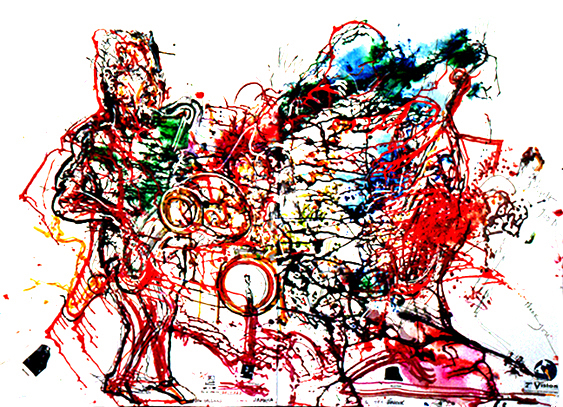 |
| MILFORD GRAVES | KIDD JORDAN | WILLIAM PARKER |
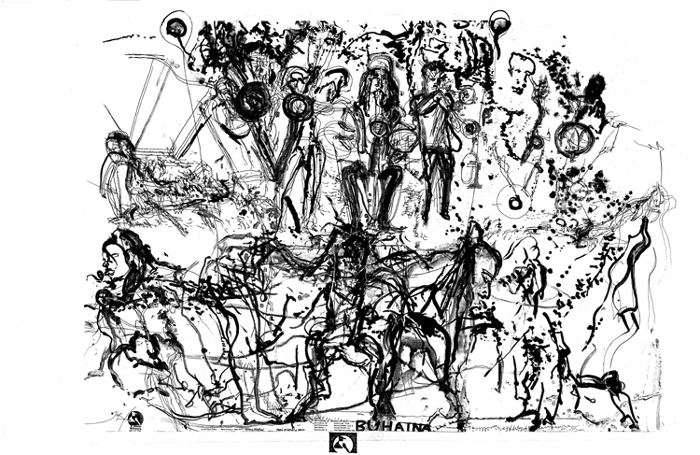 |
| ROY CAMPBELL JR. | "BUHAINA THE GREAT" |
Roy Campbell Jr. "Buhaina The Great"
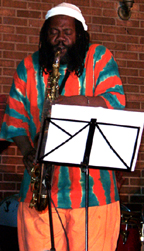 In
honor of the groundbreaking drummer Art Blakey, Roy Campbell wrote the
five-part suite "Buhaina the Great." It was performed by a tentet
that put electricity and fire into the vibrant composition. The lengthy
upbeat romper was augmented by four interpretive modern dancers, including
Patricia Nicholson, Maria Mitchell, and Aleta Hayes, who demonstrated
American, Oriental, and African themes within their limber steps. Campbell's
music showed the power and muscle typical of the Blakey style. Everyone
had a share of the spotlight, including Alex Harding and Andrew Lamb (pictured),
who both exploded on their solos. Pianist Andrew Bemkey punctuated the
highly rhythmic music with precise distinctiveness, while the pacesetting
trio on percussion - Reggie Nicholson, Takik Abdullah and Michael Wimberly
- kept the tempo at a fever pitch. The music had the essence of Blakey
as seen through the inspirational mind of Campbell, whose flame-throwing
trumpet was an earth-scorcher. It was a dynamic and well-coordinated presentation
of two art forms.
In
honor of the groundbreaking drummer Art Blakey, Roy Campbell wrote the
five-part suite "Buhaina the Great." It was performed by a tentet
that put electricity and fire into the vibrant composition. The lengthy
upbeat romper was augmented by four interpretive modern dancers, including
Patricia Nicholson, Maria Mitchell, and Aleta Hayes, who demonstrated
American, Oriental, and African themes within their limber steps. Campbell's
music showed the power and muscle typical of the Blakey style. Everyone
had a share of the spotlight, including Alex Harding and Andrew Lamb (pictured),
who both exploded on their solos. Pianist Andrew Bemkey punctuated the
highly rhythmic music with precise distinctiveness, while the pacesetting
trio on percussion - Reggie Nicholson, Takik Abdullah and Michael Wimberly
- kept the tempo at a fever pitch. The music had the essence of Blakey
as seen through the inspirational mind of Campbell, whose flame-throwing
trumpet was an earth-scorcher. It was a dynamic and well-coordinated presentation
of two art forms.
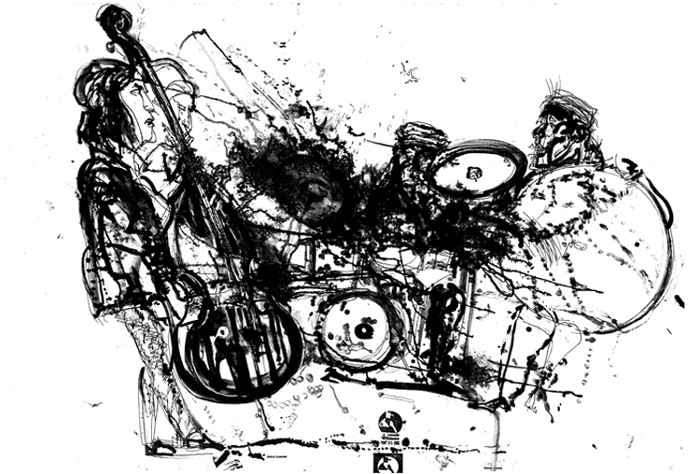 |
| JOELLE LEANDRE | HAMID DRAKE |
Joelle Leandre / Hamid Drake
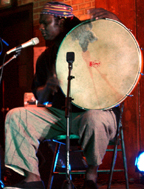 Joelle
Leandre and Hamid Drake played an exhilarating bass/drum duet. These two
astute conversationalists intertwined intensely intimate yet provocative
communiqués that bridged the gap between cultures as diverse as
Middle Eastern and Indigenous American. Drake opened the parlay on the
huge frame drum as he tapped out a complex cadence while invoking a higher
spirit with his mesmerizing chanting. Leandre followed with exquisite
strumming and plucking to establish layers of dark tonality. She also
beckoned her own spirit world with her unique form of vocalese. It all
meshed on this late-night closing act of intense beauty.
Joelle
Leandre and Hamid Drake played an exhilarating bass/drum duet. These two
astute conversationalists intertwined intensely intimate yet provocative
communiqués that bridged the gap between cultures as diverse as
Middle Eastern and Indigenous American. Drake opened the parlay on the
huge frame drum as he tapped out a complex cadence while invoking a higher
spirit with his mesmerizing chanting. Leandre followed with exquisite
strumming and plucking to establish layers of dark tonality. She also
beckoned her own spirit world with her unique form of vocalese. It all
meshed on this late-night closing act of intense beauty.
| 26 MAY |
Ellen Christi Quartet
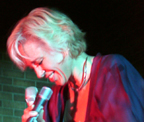 Vocal
and vocalese artist Ellen Christi cooked. She scatted, shouted, sprayed,
and splattered her alien language through dual mikes to set the tone for
her power band. Guitarist Ralph Strum kept the rhythm hot and heavy, Hamid
Drake pounded out volumes of beat, and William Parker raced the neck of
his bass to keep the set in constant motion.
Vocal
and vocalese artist Ellen Christi cooked. She scatted, shouted, sprayed,
and splattered her alien language through dual mikes to set the tone for
her power band. Guitarist Ralph Strum kept the rhythm hot and heavy, Hamid
Drake pounded out volumes of beat, and William Parker raced the neck of
his bass to keep the set in constant motion.
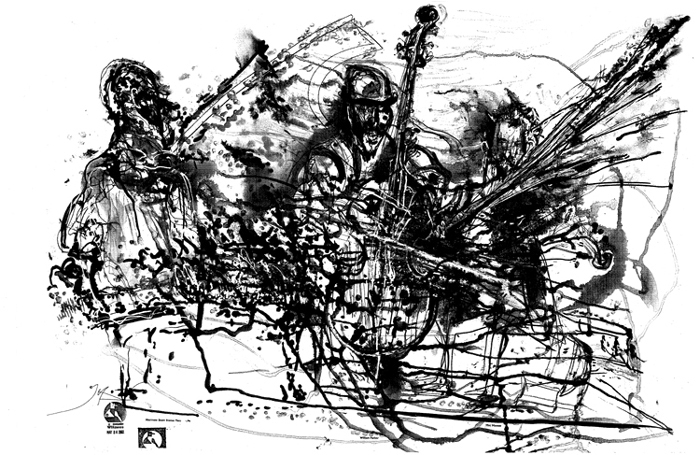 |
| MATTHEW SHIPP STRING TRIO |
Matthew Shipp String Trio
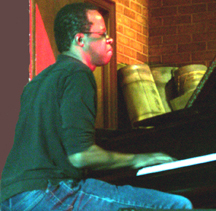 Matthew
Shipp has many projects going at any one time, and the full schedule only
seems to enhance his artistry. His String Trio, with Mat Maneri on viola
and William Parker on bass, played music filled with deep emotion and
density. There was a somber atmosphere cast by these heavyweights. Shipp
has always favored the dark, melancholy side of the piano, and with Maneri
to support that role, the music took on weighty proportions. The rich
tones of the viola melded perfectly into the storm being brewed by Shipp,
and Parker fueled the fires with deft arco playing and string manipulation.
This music sweeps one up into a trance state where witches and dragons
play subconscious games with the psyche. The improvisations were highly
complex, and the interplay by the three fully entangled. Whether engaged
in developing intricate solos or responding collectively to the abounding
vibrations, the String Trio excelled. They cast a huge shadow.
Matthew
Shipp has many projects going at any one time, and the full schedule only
seems to enhance his artistry. His String Trio, with Mat Maneri on viola
and William Parker on bass, played music filled with deep emotion and
density. There was a somber atmosphere cast by these heavyweights. Shipp
has always favored the dark, melancholy side of the piano, and with Maneri
to support that role, the music took on weighty proportions. The rich
tones of the viola melded perfectly into the storm being brewed by Shipp,
and Parker fueled the fires with deft arco playing and string manipulation.
This music sweeps one up into a trance state where witches and dragons
play subconscious games with the psyche. The improvisations were highly
complex, and the interplay by the three fully entangled. Whether engaged
in developing intricate solos or responding collectively to the abounding
vibrations, the String Trio excelled. They cast a huge shadow.
Whit Dickey / Joe Morris / Rob Brown
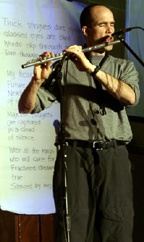 As
a drummer, Whit Dickey can be quite explosive, but when he surrounded
himself with guitarist Joe Morris and alto player Rob Brown, he became
a member of a telepathic threesome spitting out intricately devised improvisations.
Dickey rolled on as a forceful tidal wave while Rob Brown proved once
again why he is recognized as the premier alto player of this time. Brown's
solos are endurance tests, but he makes it all sound logical and connected.
Morris visually appeared to be unemotional but the music he put forth
was full of feeling. It poured out of his instrument in methodical order
and seemingly effortless manner, washing over everything with clarity
and unblurred precision. Brown and Morris made high-register sparks fly
while Dickey snared them in his net and fanned them into flame.
As
a drummer, Whit Dickey can be quite explosive, but when he surrounded
himself with guitarist Joe Morris and alto player Rob Brown, he became
a member of a telepathic threesome spitting out intricately devised improvisations.
Dickey rolled on as a forceful tidal wave while Rob Brown proved once
again why he is recognized as the premier alto player of this time. Brown's
solos are endurance tests, but he makes it all sound logical and connected.
Morris visually appeared to be unemotional but the music he put forth
was full of feeling. It poured out of his instrument in methodical order
and seemingly effortless manner, washing over everything with clarity
and unblurred precision. Brown and Morris made high-register sparks fly
while Dickey snared them in his net and fanned them into flame.
Kidd Jordan / Fred Anderson / William Parker / Hamid Drake
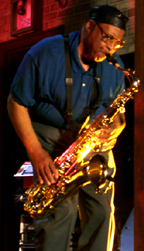 It
would be impossible to convey in adequate terms the amount of raw energy
and emotion transmitted by Kidd Jordan, Fred Anderson, William Parker,
and Hamid Drake. For well over an hour, the four dynamos spewed molten
lava in a continuous, unrestrained, take-no-prisoners session. In an extreme
display of creative talent riding on the tail of a cyclone, these four
gave an overly enthusiastic crowd just what they wanted. Anderson opened
with a burning solo that put into perpetual motion the rocket ship that
would still be orbiting out there, if the hour had not gotten so late.
Enter Drake and Parker with pounding waves of current, and then Jordan
with his blistering yet fully coherent form of communication. Collective
improvisation was the vehicle on which they all soared; yet, their individual
talent was the propellant. Anderson would evoke a series of semi-rhythmic
statements that would inspire Jordan to take it up several notches, while
Drake and Parker - totally drenched from the ordeal - would turn into
whirling dervishes to spin out their message. With the audience in frenzy
mode, the typhoon kept coming, wave after wave, until it culminated in
a natural bombastic ending. The two elder statesmen on horns were not
finished, though, for Jordan and Anderson played an encore duet starting
as a slow blues but again evolving into levitation-inducing vibrations.
When reflecting on significant emotional events, this will rank in the
upper register.
It
would be impossible to convey in adequate terms the amount of raw energy
and emotion transmitted by Kidd Jordan, Fred Anderson, William Parker,
and Hamid Drake. For well over an hour, the four dynamos spewed molten
lava in a continuous, unrestrained, take-no-prisoners session. In an extreme
display of creative talent riding on the tail of a cyclone, these four
gave an overly enthusiastic crowd just what they wanted. Anderson opened
with a burning solo that put into perpetual motion the rocket ship that
would still be orbiting out there, if the hour had not gotten so late.
Enter Drake and Parker with pounding waves of current, and then Jordan
with his blistering yet fully coherent form of communication. Collective
improvisation was the vehicle on which they all soared; yet, their individual
talent was the propellant. Anderson would evoke a series of semi-rhythmic
statements that would inspire Jordan to take it up several notches, while
Drake and Parker - totally drenched from the ordeal - would turn into
whirling dervishes to spin out their message. With the audience in frenzy
mode, the typhoon kept coming, wave after wave, until it culminated in
a natural bombastic ending. The two elder statesmen on horns were not
finished, though, for Jordan and Anderson played an encore duet starting
as a slow blues but again evolving into levitation-inducing vibrations.
When reflecting on significant emotional events, this will rank in the
upper register.
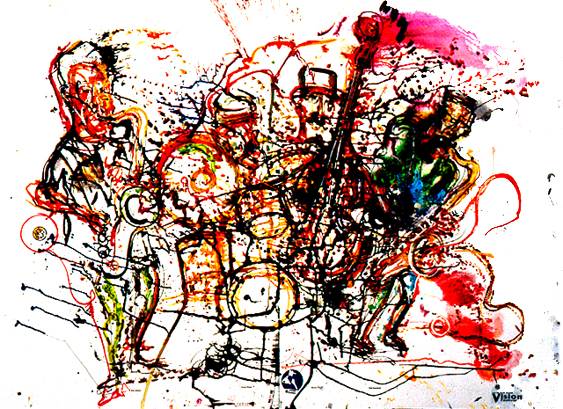 |
| KIDD JORDAN | FRED ANDERSON | WILLIAM PARKER | HAMID DRAKE |
| 27 MAY |
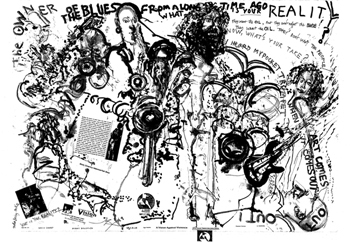 |
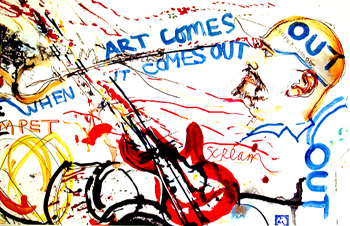 |
| JAYNE CORTEZ'S FIRESPITTERS | |
Jayne Cortez's Firespitters
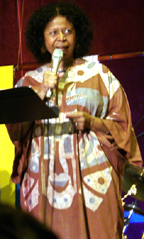 Jayne
Cortez is the conscience of the world. She sees the wrongs all around
us, and she tells it like it is without pulling any punches. Her band
also made a strong statement on this Don Cherry tribute evening. Cherry's
son Michael played an opening piano solo to start the honors, and from
then on, Cortez blasted society with stinging words of reality while the
band made definitive exclamation points to her words. Alex Harding was
emotionally emotive on baritone, Bern Nix electrified the air through
his guitar, Cherry's daughter Jan was very expressive on violin, and Cortez's
son Denardo Coleman punched the drum skins with power to spare to solidify
the band's contribution. Cortez's socially aware phrasing dominated the
atmosphere. She is here and now, and she hits you between the eyes with
no holds barred. The impact was significant.
Jayne
Cortez is the conscience of the world. She sees the wrongs all around
us, and she tells it like it is without pulling any punches. Her band
also made a strong statement on this Don Cherry tribute evening. Cherry's
son Michael played an opening piano solo to start the honors, and from
then on, Cortez blasted society with stinging words of reality while the
band made definitive exclamation points to her words. Alex Harding was
emotionally emotive on baritone, Bern Nix electrified the air through
his guitar, Cherry's daughter Jan was very expressive on violin, and Cortez's
son Denardo Coleman punched the drum skins with power to spare to solidify
the band's contribution. Cortez's socially aware phrasing dominated the
atmosphere. She is here and now, and she hits you between the eyes with
no holds barred. The impact was significant.
Dewey Redman Quartet
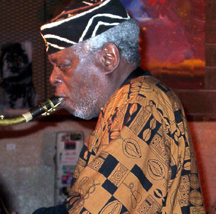 Dewey
Redman is another legend that keeps on going with solid performances and
exciting music. He surrounded himself with a young rhythm section and
proceeded to blow with authority for this entire set. Redman has a crowd-pleasing
formula of first playing a tune that is out and then taking the next piece
inside. Both his live performances and recordings seem to have this flexible
characteristic. Redman also knows how to get a crowd into the music with
his personable style and encouragement, including not being shy about
parading through the audience or requesting a vocal feedback to his singing.
Pianist Barney McAll from Australia worked neatly with the master, punctuating
the tunes with a positive style. John Menegon and Matt Wilson were also
strong rhythm supporters, but the show was all Redman. He played extended
solos, pushing guttural vocal tones through his horn as well as notes.
Although he reveled in playing bop and the blues, it was his more aggressive
freeform tunes that carried the day. And he did it so effortlessly.
Dewey
Redman is another legend that keeps on going with solid performances and
exciting music. He surrounded himself with a young rhythm section and
proceeded to blow with authority for this entire set. Redman has a crowd-pleasing
formula of first playing a tune that is out and then taking the next piece
inside. Both his live performances and recordings seem to have this flexible
characteristic. Redman also knows how to get a crowd into the music with
his personable style and encouragement, including not being shy about
parading through the audience or requesting a vocal feedback to his singing.
Pianist Barney McAll from Australia worked neatly with the master, punctuating
the tunes with a positive style. John Menegon and Matt Wilson were also
strong rhythm supporters, but the show was all Redman. He played extended
solos, pushing guttural vocal tones through his horn as well as notes.
Although he reveled in playing bop and the blues, it was his more aggressive
freeform tunes that carried the day. And he did it so effortlessly.
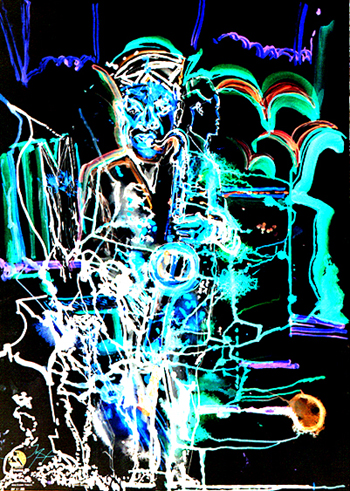 |
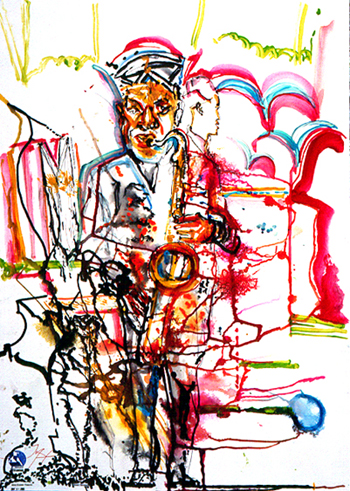 |
| DEWEY REDMAN QUARTET | |
Don Cherry Memorial Band
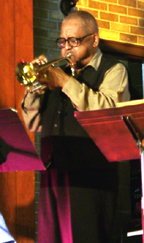 Karl
Berger's tribute to Don Cherry was emotional and filled with love. He
assembled a highly talented band of musicians who had played with Cherry,
making the occasion a very extraordinary event. They presented an array
of Cherry's compositions and tunes associated with him while a huge portrait
of Cherry hung in the background as a constant reminder of his contributions
to music and life. Frank Lowe was at his best on this night and played
with more dedication than I have seen in him in quite a while. Bobby Bradford
(pictured) was marvelous on cornet, and the vocals of Ingrid Sertso were
a fitting reminder of Cherry's contributions. This was a large contingent
anchored by tuba player Bob Stewart and bassist Mark Helias and ignited
by the versatility of Peter Apfelbaum. Berger alternated between piano
and vibes, making the definitive references to Cherry's work while showing
his own exciting style that has endured for decades. The spirit of Cherry
was present throughout the diverse set that showed many sides of the great
trumpeter. Berger was there with him, and he shared those musical memories
on this special night.
Karl
Berger's tribute to Don Cherry was emotional and filled with love. He
assembled a highly talented band of musicians who had played with Cherry,
making the occasion a very extraordinary event. They presented an array
of Cherry's compositions and tunes associated with him while a huge portrait
of Cherry hung in the background as a constant reminder of his contributions
to music and life. Frank Lowe was at his best on this night and played
with more dedication than I have seen in him in quite a while. Bobby Bradford
(pictured) was marvelous on cornet, and the vocals of Ingrid Sertso were
a fitting reminder of Cherry's contributions. This was a large contingent
anchored by tuba player Bob Stewart and bassist Mark Helias and ignited
by the versatility of Peter Apfelbaum. Berger alternated between piano
and vibes, making the definitive references to Cherry's work while showing
his own exciting style that has endured for decades. The spirit of Cherry
was present throughout the diverse set that showed many sides of the great
trumpeter. Berger was there with him, and he shared those musical memories
on this special night.
Pyramid Trio
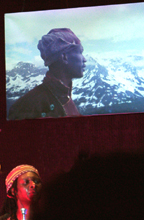 Roy
Campbell, William Parker, and Hamid Drake participate actively in multiple
projects either together or individually, but the Pyramid Trio has its
own identity and sound. Campbell becomes the focus, playing trumpet and
flute, Drake expands on his ever-changing percussion tactics, and Parker
is able to dabble with percussion and his thumb-stroked dosengoni in addition
to the bass. The trio offers a wealth of artistic opportunity for the
three. On this set, they played four very diverse tunes ranging from mystical
to upbeat to political to serene. On all tunes, there was close interaction
and astute empathy. The band was highly rhythmic, particularly when both
Drake and Parker set the joint pace. Campbell also sang the strained lyrics
to the upbeat "Malcolm, Martin, and Mandela," a simple melody
that was expanded instrumentally into a solid piece. Campbell's solos
on the free improvisations were the meat of the set, and the heady support
from his companions made the fires burn brightly.
Roy
Campbell, William Parker, and Hamid Drake participate actively in multiple
projects either together or individually, but the Pyramid Trio has its
own identity and sound. Campbell becomes the focus, playing trumpet and
flute, Drake expands on his ever-changing percussion tactics, and Parker
is able to dabble with percussion and his thumb-stroked dosengoni in addition
to the bass. The trio offers a wealth of artistic opportunity for the
three. On this set, they played four very diverse tunes ranging from mystical
to upbeat to political to serene. On all tunes, there was close interaction
and astute empathy. The band was highly rhythmic, particularly when both
Drake and Parker set the joint pace. Campbell also sang the strained lyrics
to the upbeat "Malcolm, Martin, and Mandela," a simple melody
that was expanded instrumentally into a solid piece. Campbell's solos
on the free improvisations were the meat of the set, and the heady support
from his companions made the fires burn brightly.
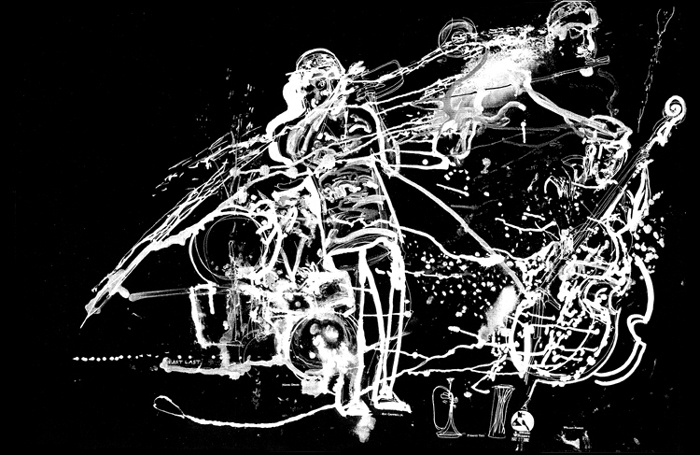 |
| PYRAMID TRIO |
| 28 MAY |
Assif Tsahar's New York Underground Symphony
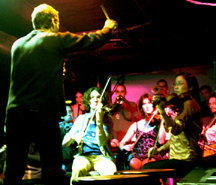 Everyone
expected Assif Tsahar to be blowing his tenor wildly, but instead, they
witnessed his adept ability to direct an orchestra using the conduction
method. Tsahar had every eye of his New York Underground Symphony orchestra
riveted on him, and he picked and chose whom he wanted to play and how
he wanted them to play it by his adroit handling of the baton. No sheet
music was evident. The strings played a critical role with softened tonality,
but there was no shortage of horn players in this diverse ensemble. The
trumpets and trombones exploded on Tsahar's command, only to recede into
quietude as other instruments took over the lead role. The three pieces
moved through emotional mood swings ranging from pastoral to turbulent,
always reaching a crescendo in a flurry of spontaneous collectivity. Although
violins, violas, and cellos might suggest ethereal music, this was not
the case. Tsahar visited his muse, and he adroitly intertwined two sonic
extremes into a creative force. He told me the next night that some people
were disappointed in this new venture, but I found it both challenging
and refreshing.
Everyone
expected Assif Tsahar to be blowing his tenor wildly, but instead, they
witnessed his adept ability to direct an orchestra using the conduction
method. Tsahar had every eye of his New York Underground Symphony orchestra
riveted on him, and he picked and chose whom he wanted to play and how
he wanted them to play it by his adroit handling of the baton. No sheet
music was evident. The strings played a critical role with softened tonality,
but there was no shortage of horn players in this diverse ensemble. The
trumpets and trombones exploded on Tsahar's command, only to recede into
quietude as other instruments took over the lead role. The three pieces
moved through emotional mood swings ranging from pastoral to turbulent,
always reaching a crescendo in a flurry of spontaneous collectivity. Although
violins, violas, and cellos might suggest ethereal music, this was not
the case. Tsahar visited his muse, and he adroitly intertwined two sonic
extremes into a creative force. He told me the next night that some people
were disappointed in this new venture, but I found it both challenging
and refreshing.
Freedomland
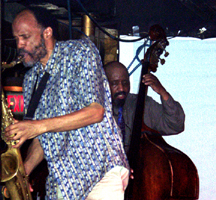 Freedomland
is a relatively new alignment of veteran Downtown New York musicians featuring
the exciting reed and brass playing of Daniel Carter. The group has a
triple bottom end with William Parker on bass, Dave Sewelson on baritone,
and Dave Hofstra on tuba. Providing the rhythmic power is drummer Dee
Pop, who is making his first entry into improvised music with this group.
Previously he had plied his trade with rock bands. Freedomland is a showcase
for Carter's many talents. He randomly runs through any number of woodwinds
and also pulls out the trumpet from his bag of many instruments. Freedomland
is a power group with a rhythmic foundation, but when it cranks up into
high gear, its freeform arrhythmic energy is dynamite. The baritone/tuba
combination gives the group its unique identity, although Sewelson also
plays tenor in sparring matches with Carter. The band has recently released
its first recording Amusement Park.
Freedomland
is a relatively new alignment of veteran Downtown New York musicians featuring
the exciting reed and brass playing of Daniel Carter. The group has a
triple bottom end with William Parker on bass, Dave Sewelson on baritone,
and Dave Hofstra on tuba. Providing the rhythmic power is drummer Dee
Pop, who is making his first entry into improvised music with this group.
Previously he had plied his trade with rock bands. Freedomland is a showcase
for Carter's many talents. He randomly runs through any number of woodwinds
and also pulls out the trumpet from his bag of many instruments. Freedomland
is a power group with a rhythmic foundation, but when it cranks up into
high gear, its freeform arrhythmic energy is dynamite. The baritone/tuba
combination gives the group its unique identity, although Sewelson also
plays tenor in sparring matches with Carter. The band has recently released
its first recording Amusement Park.
Other Dimensions in Music
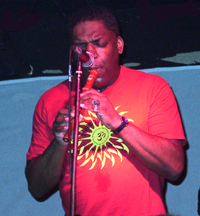 Other
Dimensions in Music is probably the hardest working band in the business.
From the first downbeat to the last note, the four musicians exude total
energy to go along with the creative forces. While William Parker and
Rashid Bakr push relentlessly, Roy Campbell makes his trumpet sing and
Daniel Carter explodes on countless reeds. This session found them in
full synchronization, which is what we have come to expect from this band
that has been playing together for several decades. The tempo is incredibly
fast, and the four artists keep pace at these breakneck speeds. Carter
is a marvel to hear. He picks up any one of his half-dozen horns and spits
out fire and brimstone - all of which has a logical progression and communicable
phrasing. The band appears to be having fun while all this creativity
is happening. They inject woops and hollers to incite more action, and
the steamroller moves on and on. ODIM is a thrilling band that is certain
to keep one's heartbeat pounding.
Other
Dimensions in Music is probably the hardest working band in the business.
From the first downbeat to the last note, the four musicians exude total
energy to go along with the creative forces. While William Parker and
Rashid Bakr push relentlessly, Roy Campbell makes his trumpet sing and
Daniel Carter explodes on countless reeds. This session found them in
full synchronization, which is what we have come to expect from this band
that has been playing together for several decades. The tempo is incredibly
fast, and the four artists keep pace at these breakneck speeds. Carter
is a marvel to hear. He picks up any one of his half-dozen horns and spits
out fire and brimstone - all of which has a logical progression and communicable
phrasing. The band appears to be having fun while all this creativity
is happening. They inject woops and hollers to incite more action, and
the steamroller moves on and on. ODIM is a thrilling band that is certain
to keep one's heartbeat pounding.
Otic Band
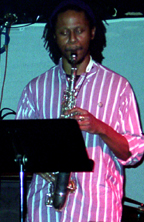 The
Otic Band led by bass player Todd Nicholson is a young group that has
a solid foundation in the music. They played unstructured original music
with considerable spirit and power. Nicholson is a staunch leader who
sets a resonant, often-booming pace, and the three-man front line of Nate
Wooley, Mikel Priester (pictured), and Brent Bagwell built the music to
intense levels. Priester in particular was impressive on alto. He showed
fine form and great chops. We should be hearing more of him as he continues
to develop. All three horn men were excellent soloists, and the push from
Nicholson and Pride was non-stop. The future of the music is in good hands
with young talent such as this.
The
Otic Band led by bass player Todd Nicholson is a young group that has
a solid foundation in the music. They played unstructured original music
with considerable spirit and power. Nicholson is a staunch leader who
sets a resonant, often-booming pace, and the three-man front line of Nate
Wooley, Mikel Priester (pictured), and Brent Bagwell built the music to
intense levels. Priester in particular was impressive on alto. He showed
fine form and great chops. We should be hearing more of him as he continues
to develop. All three horn men were excellent soloists, and the push from
Nicholson and Pride was non-stop. The future of the music is in good hands
with young talent such as this.
| 29 MAY |
William Parker's Little Huey Creative Music Orchestra
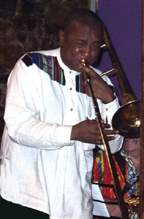 William
Parker's Little Huey Orchestra is an ongoing project of love for the creative
art form. With each ensuing reunion of this band, he is able to instill
freshness and originality into the music. Little Huey is a highly talented
assemblage of musicians, and Parker's compositions are stimulating for
them. They offer each of the artists a major role in the construction
of the intricate pieces, which typically are set-length offerings. On
this night, Parker worked in quiet dynamics and serene tonality before
the more obvious explosiveness took hold to generate another landmark
session. Although the band performs together sporadically (this was their
first 2002 encounter), they play with the precision of a regularly working
band. The soloists were all excellent, with Sabir Mateen and Dick Griffin
(pictured) being notable standouts in the super lineup of stars. Parker
does not need to conduct this disciplined group; he remains in the back
pushing on the bass and allowing the creativity to come forth unencumbered
by direction. It is a formula that works to perfection.
William
Parker's Little Huey Orchestra is an ongoing project of love for the creative
art form. With each ensuing reunion of this band, he is able to instill
freshness and originality into the music. Little Huey is a highly talented
assemblage of musicians, and Parker's compositions are stimulating for
them. They offer each of the artists a major role in the construction
of the intricate pieces, which typically are set-length offerings. On
this night, Parker worked in quiet dynamics and serene tonality before
the more obvious explosiveness took hold to generate another landmark
session. Although the band performs together sporadically (this was their
first 2002 encounter), they play with the precision of a regularly working
band. The soloists were all excellent, with Sabir Mateen and Dick Griffin
(pictured) being notable standouts in the super lineup of stars. Parker
does not need to conduct this disciplined group; he remains in the back
pushing on the bass and allowing the creativity to come forth unencumbered
by direction. It is a formula that works to perfection.
| 30 MAY |
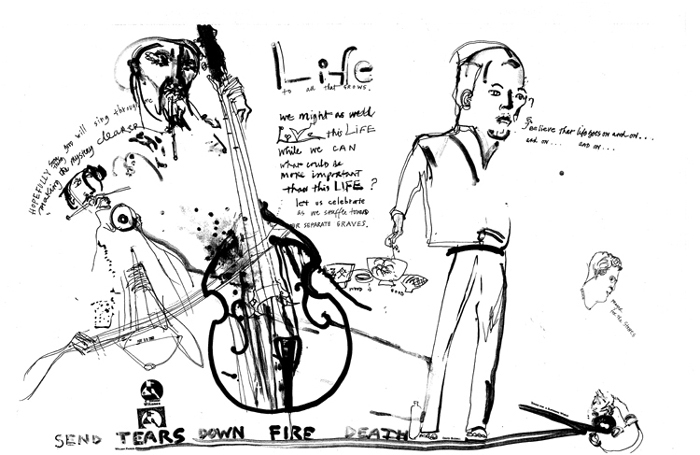 |
| SONGS FOR A SUFFERING WORLD |
Songs for a Suffering World
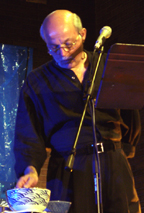 Poet
David Budbill has teamed with William Parker on several occasions for
public performances and recordings. On this date, the bass player added
color, texture, and vocal/percussion accompaniment to the direct, straightforward
recitations by Budbill. Budbill's poetry touched on the human experience
with emphasis on 9/11. He took a macro viewpoint of life, and his verse
related regularly to nature and the environment. His perspective honored
the Asian aesthetic and ancient wisdom. Budbill approaches life in a pragmatic
manner but always seems to find the good in people and situations. Parker
chanted, used percussion instruments, and worked his bass in consort with
the telling words flowing so eloquently from Budbill, who also played
chimes through striking glass bowls of varying size. The two art forms
merged neatly through their efforts.
Poet
David Budbill has teamed with William Parker on several occasions for
public performances and recordings. On this date, the bass player added
color, texture, and vocal/percussion accompaniment to the direct, straightforward
recitations by Budbill. Budbill's poetry touched on the human experience
with emphasis on 9/11. He took a macro viewpoint of life, and his verse
related regularly to nature and the environment. His perspective honored
the Asian aesthetic and ancient wisdom. Budbill approaches life in a pragmatic
manner but always seems to find the good in people and situations. Parker
chanted, used percussion instruments, and worked his bass in consort with
the telling words flowing so eloquently from Budbill, who also played
chimes through striking glass bowls of varying size. The two art forms
merged neatly through their efforts.
Paul Dunmall / Paul Rogers / Gerry Hemingway
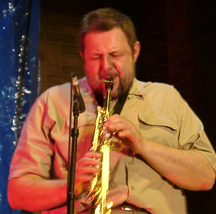 British
British
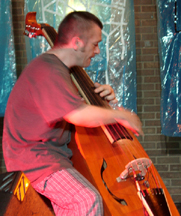 saxophonists
have a stark, serious quality to their playing, and Paul Dunmall exemplifies
the style. He blew with religious fervor on a set with percussionist extraordinaire
Gerry Hemingway and stellar bassist Paul Rogers. The program contained
one set-long free improvisation that saw the trio listening intently to
each other and communicating flawlessly. Dunmall was often demon-like
on tenor, blowing with sterile, emotionless zeal. Rogers played an interesting
acoustic bass, which was a six-string custom-made instrument of smaller
size and not as much resonance as the full-sized model. Still, he was
masterful in eking out lengthy improvised solos. Watching Hemingway is
always a treat. He dived deeply into the music, using multiple percussive
tactics to motivate the group. His rubbing of the skins produced an unusual
tonal quality on the several quiet moments of the performance. The raw
emotion that characterized the majority of the set was highly refined
and penetrating. This trio was unquestionably accordant on this night.
saxophonists
have a stark, serious quality to their playing, and Paul Dunmall exemplifies
the style. He blew with religious fervor on a set with percussionist extraordinaire
Gerry Hemingway and stellar bassist Paul Rogers. The program contained
one set-long free improvisation that saw the trio listening intently to
each other and communicating flawlessly. Dunmall was often demon-like
on tenor, blowing with sterile, emotionless zeal. Rogers played an interesting
acoustic bass, which was a six-string custom-made instrument of smaller
size and not as much resonance as the full-sized model. Still, he was
masterful in eking out lengthy improvised solos. Watching Hemingway is
always a treat. He dived deeply into the music, using multiple percussive
tactics to motivate the group. His rubbing of the skins produced an unusual
tonal quality on the several quiet moments of the performance. The raw
emotion that characterized the majority of the set was highly refined
and penetrating. This trio was unquestionably accordant on this night.
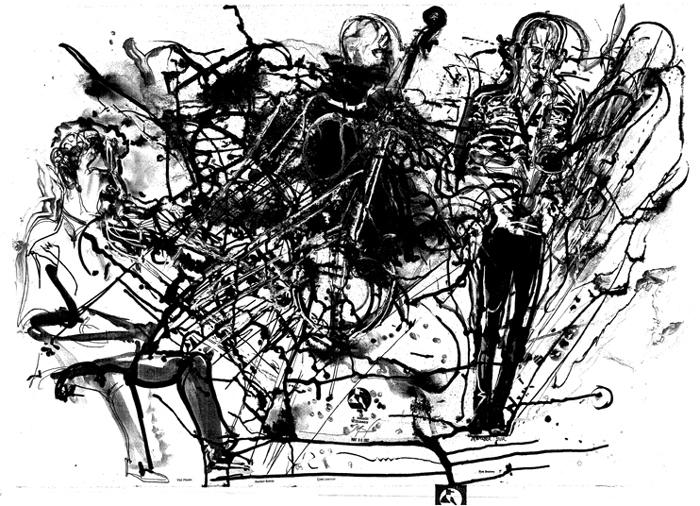 |
| ROB BROWN QUARTET |
Rob Brown Quartet
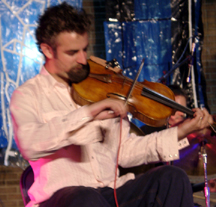 Rob
Brown appeared with several bands during the festival, but he also fronted
his own quartet. The instrumental mix of reeds and viola worked very well.
While Brown continued to soar on high on alto and flute, the intense string
playing of Mat Maneri complemented the sound. The young rhythm section
of Chris Lightcap and Andrew Barker fanned the flames with considerable
push while both Brown and Maneri took off on flights of fancy. Brown is
noted for taking long, well-developed solos, and he cut loose on this
session with extended dissertations augmented by terse interjections from
Maneri's high-pitched viola. The music was very spirited, taking the audience
on long rides of improvised beauty. The ideas continued to roll off Brown's
tongue, and Maneri was in great form as well. This band played daring
music with plenty of drive.
Rob
Brown appeared with several bands during the festival, but he also fronted
his own quartet. The instrumental mix of reeds and viola worked very well.
While Brown continued to soar on high on alto and flute, the intense string
playing of Mat Maneri complemented the sound. The young rhythm section
of Chris Lightcap and Andrew Barker fanned the flames with considerable
push while both Brown and Maneri took off on flights of fancy. Brown is
noted for taking long, well-developed solos, and he cut loose on this
session with extended dissertations augmented by terse interjections from
Maneri's high-pitched viola. The music was very spirited, taking the audience
on long rides of improvised beauty. The ideas continued to roll off Brown's
tongue, and Maneri was in great form as well. This band played daring
music with plenty of drive.
Douglas Ewart Inventions
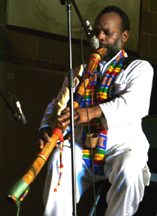 Douglas
Douglas
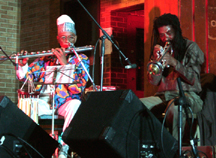 Ewart
has been experimenting with unique instrumental forms for decades, and
this latest group called Inventions brought out the ultra-exotic nature
of his musical thought process. He captured the sound and spirit of Oceania
and Southeast Asia and repackaged it with delicately constructed free
improvisations played on unusual looking and sounding hollow reeds. On
this special night, Ewart enlisted Joseph Jarman and Wadada Leo Smith,
with whom he said he had wanted to perform for some time. With three horns,
exquisite koto player Miya Masaoka, and the shaded rhythms of William
Parker and Hamid Drake, Inventions wound its way through dense rain forests,
painting a collage of multiple colors. Smith was on fire, spitting out
heavy rounds of freedom in between the quieter passages, and Jarman moved
from subtleties to overt pronouncements as the lengthy main piece unfolded.
Masaoka was sheer delight to watch as she turned the ancient instrument
into an improvising tool. The set was a highly satisfying encounter.
Ewart
has been experimenting with unique instrumental forms for decades, and
this latest group called Inventions brought out the ultra-exotic nature
of his musical thought process. He captured the sound and spirit of Oceania
and Southeast Asia and repackaged it with delicately constructed free
improvisations played on unusual looking and sounding hollow reeds. On
this special night, Ewart enlisted Joseph Jarman and Wadada Leo Smith,
with whom he said he had wanted to perform for some time. With three horns,
exquisite koto player Miya Masaoka, and the shaded rhythms of William
Parker and Hamid Drake, Inventions wound its way through dense rain forests,
painting a collage of multiple colors. Smith was on fire, spitting out
heavy rounds of freedom in between the quieter passages, and Jarman moved
from subtleties to overt pronouncements as the lengthy main piece unfolded.
Masaoka was sheer delight to watch as she turned the ancient instrument
into an improvising tool. The set was a highly satisfying encounter.
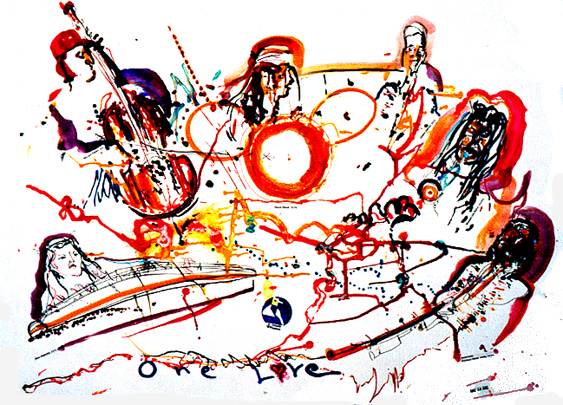 |
| DOUGLAS EWART INVENTIONS |
| 31 MAY—2 JUNE |
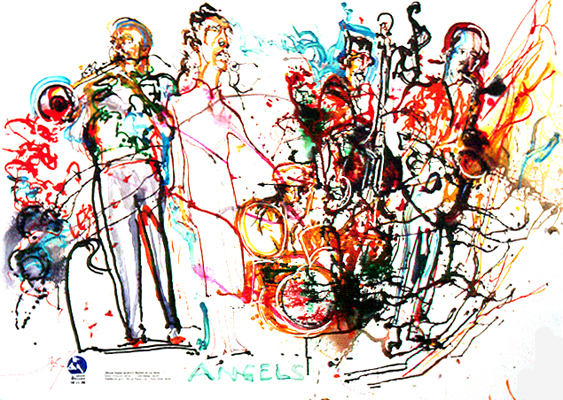 |
| WILLIAM
PARKER QUARTET'S "RAINING ON THE MOON" |
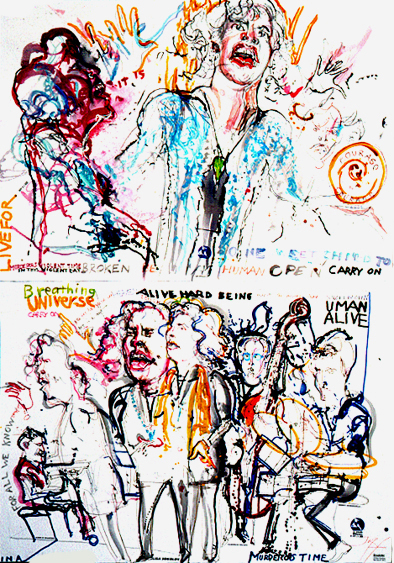 |
| LISA SOKOLOV
| JOHN DIMARTINO CAMERON BROWN | GERRY HEMINGWAY |
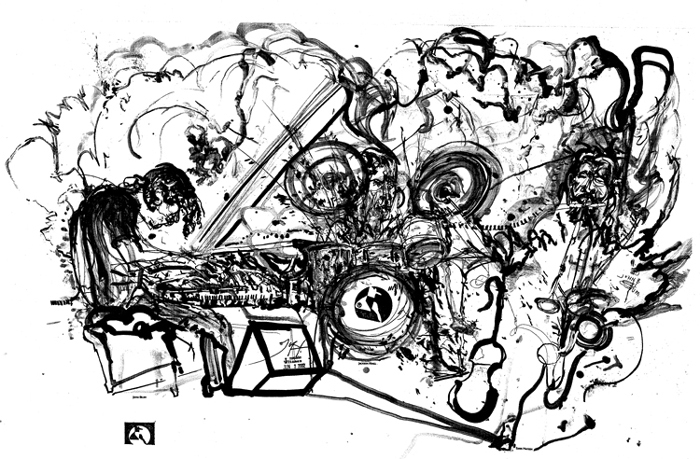 |
| JOHN BLUM | SABIR MATEEN | JACKSON KRALL |
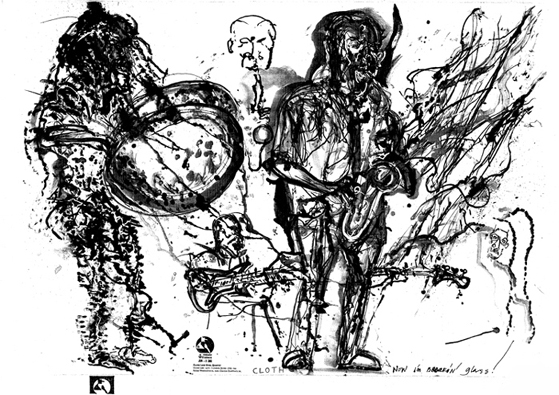 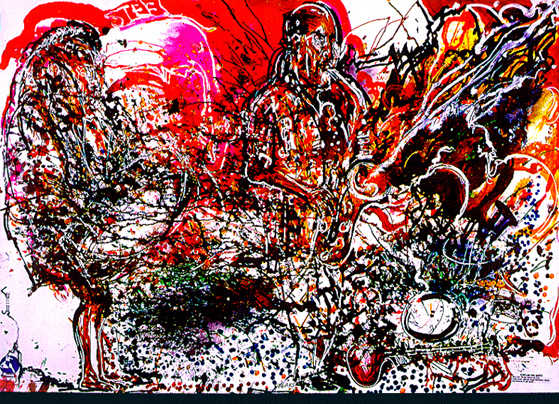 |
| OLIVER LAKE STEEL QUARTET with LYNDON ACHEE |
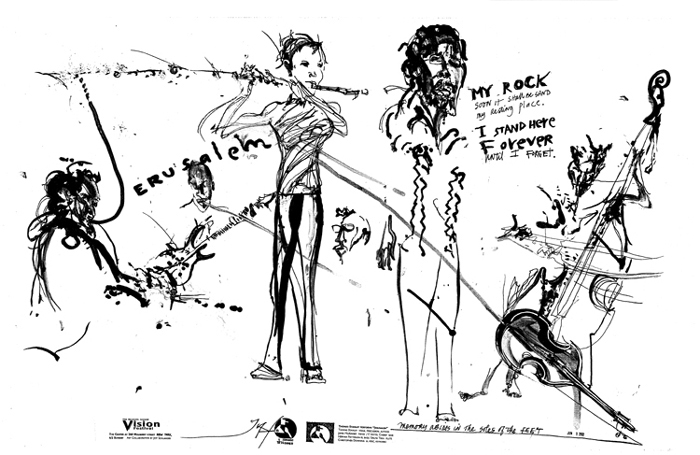 |
| THOMAS STANLEY performs "JERUSALEM" |
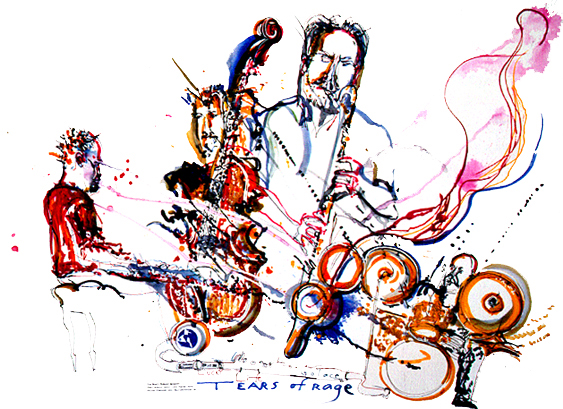 |
| MARTY EHRLICH QUARTET |
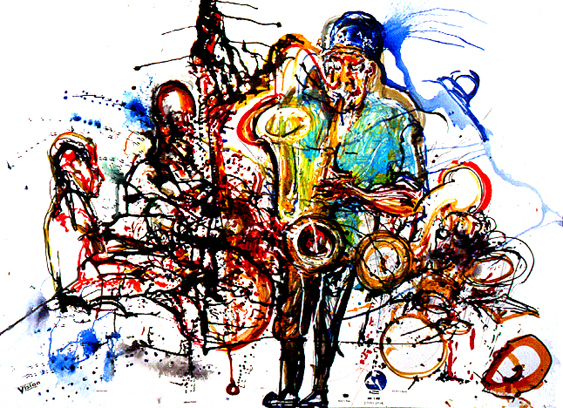 |
| DAVID S. WARE QUARTET |
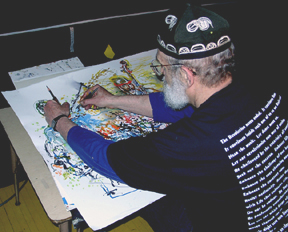 |
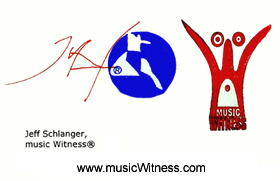 |